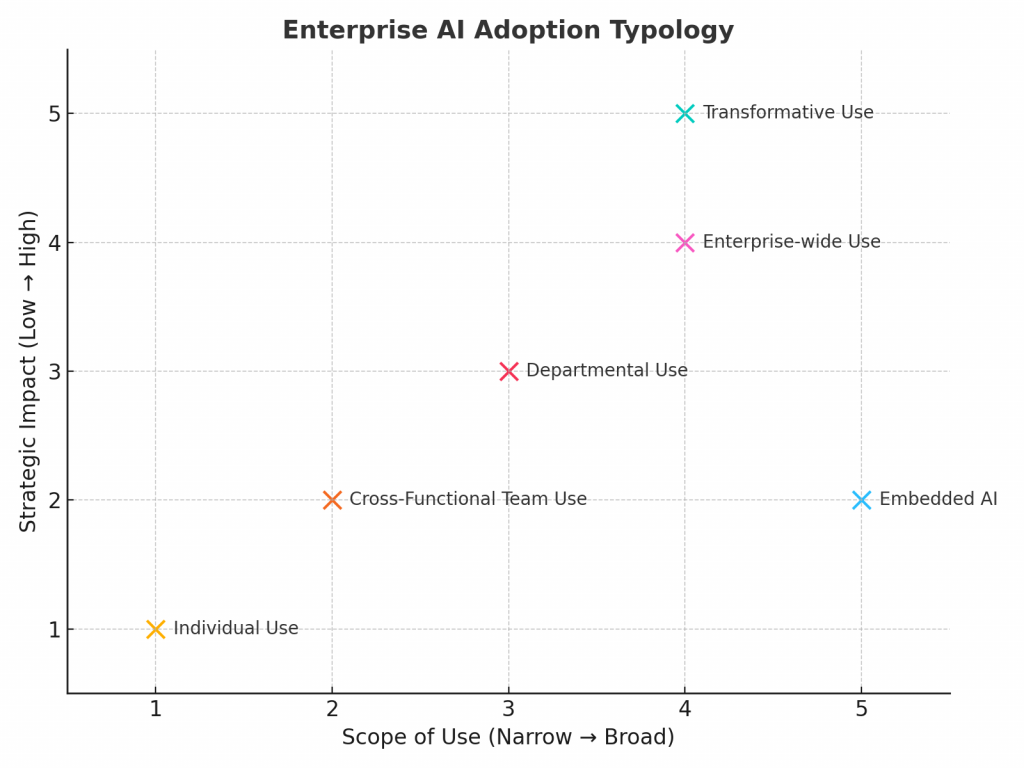This page outlines the typology I use to evaluate how organisations adopt AI.
This is not a maturity model.
The six types described here are not stages in a progression; they are types of adoption. Each reflects a distinct way AI is being used in organisations today, from uncoordinated individual use to strategic, enterprise-wide transformation.
Only some of these types reflect Enterprise AI.
Based on the working definition of Enterprise AI, the coordinated use of AI to deliver business value at scale, only Enterprise-wide AI and Transformative AI fully meet the criteria. These are my primary focus areas.
How the Typology Has Helped Me.
It has been a practical tool for navigating the chaos of modern AI. It helped me:
- Make sense of a chaotic landscape
I was seeing wildly different uses of AI, from individual hacks to enterprise-scale platforms, all labelled the same. The typology gave me a clear way to separate signals from noise. - Distinguish isolated activity from strategic impact
Some efforts delivered local wins. Others laid the groundwork for organisation-wide change. By classifying adoption types, I could focus on initiatives with scalable, strategic value, not just local optimisation. - Clarify my own focus and contribution
Rather than track everything, I chose to focus on two adoption types:
– Enterprise-wide AI, where AI is embedded across workflows, platforms, or functions
– Transformative AI, where it redefines business models or strategic value propositions - Support better decisions by leaders
By mapping adoption to organisational footprint and strategic value, the typology became a way to prioritise investments, cut through hype, and focus on what actually scales.
The examples shared on the How Enterprises Are Using AI page are filtered using this typology.
The Six Types of AI Adoption
I use the following typology to describe the different ways organisations adopt AI:
- Individual use
- Cross-functional team use
- Departmental use
- Enterprise-wide AI
- Embedded AI
- Transformative AI
Not all of these are equally relevant to my work. Below, I outline how I apply this typology and which types I prioritise when evaluating examples.
How I Distinguish the Types
This typology is based on two key dimensions:
- Scope of use — from individuals to the entire organisation
- Strategic impact — from tactical productivity to full business transformation
| Type | Scope | Strategic Impact | Notes |
| Individual Use | Narrow | Low | Personal tools, not coordinated |
| Cross-functional Teams | Mid | Mid | Collaborative, often siloed |
| Departmental Use | Functional | Mid | Structured improvement within one function |
| Enterprise-wide AI | Broad | High | Coordinated rollout across units with governance |
| Embedded AI | Broad (via vendors) | Low-Mid | Built into third-party tools, not custom solutions |
| Transformative AI | Broad | Very High | Redefines value, ops, or business model |
Note: “Embedded AI” refers to AI capabilities built into externally purchased products, not internal systems developed by the organisation.
Visual Overview

The Adoption Types I Focus On
Here are the six adoption types I use in the typology, along with their focus level, definitions, examples, and rationale. I use this as a filter, with primary focus on the types where AI becomes integral to how organisations operate, deliver value, and innovate.
Transformative AI
Focus Level: Core focus
Definition: AI used to rethink business models, operating models, or strategic value propositions.
Examples: Launching AI-first services, redefining a cost model using AI, or automating the delivery of a core business capability.
Rationale: Strategic, organisation-wide change driven by AI. This includes AI-first companies and traditional firms reimagining how they operate, deliver value, or compete.
Enterprise-wide AI
Focus Level: Strong focus
Definition: AI integrated across workflows, platforms, or functions within the organisation.
Examples: Company-wide deployment of secure GPT interfaces, AI-integrated knowledge management across departments, unified AI platforms used for audit, legal review, customer support, and internal compliance. Includes enterprise orchestration layers that manage prompts, outputs, and access across functions.
Rationale: Demonstrates coordinated, strategic adoption with governance, cross-functional impact, and delivery at scale.
Embedded AI
Focus Level: Moderate focus
Definition: AI features built into existing third-party products or services used by the organisation.
Examples: Microsoft 365 Copilot, Salesforce Einstein, Figma AI, or Canva Magic Write.
Rationale: Shows how AI-driven innovation is delivered at the product or customer level through third-party tools. Adoption is typically tactical and low-control within the enterprise. The innovation may be central to the vendor’s commercial differentiation, but not to the enterprise’s strategic transformation.
Departmental use
Focus Level: Moderate focus
Definition: AI adopted within a single business function to automate or enhance specific processes.
Examples: Chatbots used only by customer support, AI tools used exclusively by the finance team to summarise reports, or HR using AI to screen CVs.
Rationale: Demonstrates how AI improves operations in a structured, measurable way. Often a step toward enterprise-wide adoption.
Cross-functional team use
Focus Level: Occasional focus
Definition: Small, mixed-discipline teams use AI collaboratively to build tools or test ideas.
Examples: Innovation pods prototyping AI-based internal tools, or product teams combining marketing and engineering to experiment with AI capabilities.
Rationale: Included only when AI is used in a coordinated way across the team. Individual use without shared goals or delivery impact is excluded.
Individual use
Focus Level: Out of scope
Definition: AI tools used by individual employees to increase their productivity, typically without coordination or governance.
Examples: An employee using ChatGPT to summarise meeting notes or Copilot to draft an email, without broader team involvement.
Rationale: These uses are uncoordinated, lack integration, and sit outside the scope of organisational delivery or transformation.

